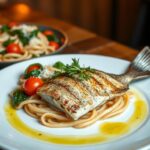Learn the secret of making an easy fish ball recipe. This homemade seafood dish mixes traditional charm with simple elegance. Originating from the warm, welcoming kitchens of East and Southeast Asia, it highlights seafood’s finest without gourmet cooking’s fuss. We’ll dive into the world of fish ball cooking methods, turning basic ingredients into something special.
This recipe uses common items like white fish, salt, water, and some white pepper, avoiding typical binders such as egg or cornflour. This approach keeps it simple and preserves the fish balls’ authentic lightness and texture, a cornerstone in Asian cuisine. For a fuller seafood experience, check out delicious lobster meat recipes. They offer a rich complement to your fish ball creations.
Key Takeaways
- Understanding the basics of an easy fish ball recipe for homemade seafood lovers.
- Recognizing the simple ingredients that make up traditional fish balls.
- Learning fish ball cooking methods to achieve that gentle, bouncy texture.
- Discovering how to add depth to your home cooking with versatile seafood dishes.
- Exploring seafood recipes that align with gourmet tastes and homey comfort.
A Brief History of Fish Balls
Exploring fish ball history takes us to the lively origins in Asian cuisine. These seafood delights are more than just meals. They’re symbols of a long-standing culinary tradition.
Fish balls started in East and Southeast Asia. They highlight how this simple food became essential for daily meals and celebrations. For those eager to try making them, mixing with other seafood ingredients is both tasty and fun.
Origins in East and South East Asia
Coastal communities made fish balls from leftover fish. They minced it into paste, formed it into balls, and cooked them. This practice helped use the whole fish harvest efficiently.
The Evolution of Fish Balls
Over time, the traditional fish ball recipe changed. Trade brought new spices and cooking styles. Ingredients like lemongrass and coconut milk made the fish balls tastier, adding to Asian cuisine.
Cultural Significance Across Countries
In different Asian cultures, fish balls mean prosperity and unity. They vary from street food to fine dining. They’re key in festivals and family events, showing a shared heritage and culinary identity.
Selecting the Right Type of Fish for Fish Balls
Knowing the best fish for fish balls is key to nailing your homemade fish ball recipe. The fish you choose changes both texture and taste. Usually, fish that are firmer and not too strong in flavor work best.

When looking for the best fish for fish balls, think about what’s available and sustainable near you. Let’s explore some top choices:
- Spanish Mackerel – It has a firm texture and tasty flavor, perfect for fish balls.
- Wolf Herring – A classic option that mixes well with other fish ball ingredients because of its smooth texture.
- Tilapia – Easy to find, it offers a softer texture and a flavor that matches many seasonings.
- Cod – Its chunky texture is great for those who prefer a heartier bite in their fish balls.
- Grouper – With fine flakes and a mild taste, it’s excellent for adding various seasonings.
Choosing the right fish is vital for your homemade fish ball recipe. It impacts both the texture and flavor balance. Use fresh, local fish to add real taste and promote sustainability. Every type of fish adds something special, making your fish balls stand out.
Essential Fish Ball Ingredients and Alternatives
Making fish balls is a mix of old customs and new ideas. It’s key to know the must-have ingredients and other choices for making this dish. This is true whether you go for a classic healthy fish ball recipe or try new tastes.
Traditional vs. Modern Ingredients
Old-school fish ball recipes use few ingredients: fresh white fish, salt, and water. Sometimes, white pepper is added to make it tastier. Today’s recipes might include garlic powder or green onions. This helps cater to different taste buds and adds variety in cooking.
Binders: Egg or Cornflour?
Choosing the right binder is crucial for the perfect fish ball texture. Eggs make fish balls tender yet firm. Cornflour is great for those avoiding gluten. It keeps the fish balls shaped well when cooked.
Seasoning Your Fish Balls for Flavor
Seasoning is key for a tasty fish ball dish. Salt and pepper are basic, but you can be bold. Try soy sauce, sesame oil, or lime juice for extra flavor. Just make sure not to hide the fish’s own taste.
| Ingredient | Role | Notes |
|---|---|---|
| Fresh White Fish | Main component | Provides the base texture and flavor |
| Salt and White Pepper | Seasoning | Enhances the natural flavors of the fish |
| Egg/Cornflour | Binder | Helps in forming and maintaining the shape |
| Optional Enhancers | Flavor Variations | Includes green onions, garlic powder, lime juice, etc. |
Trying different ingredients lets you make the fish ball recipe your own. Whether you keep it simple or add a modern twist, making cooking fish balls is both fun and rewarding.
Fish Ball Recipe: The Preparation Process
Starting to make fish balls means choosing fresh fish first. This fish is then cleaned and deboned carefully. The secret to a perfect fish ball is its texture, according to traditional methods.

First, you mince the fish finely with a sharp chopper. Then, mix the fish with salt, white pepper, and some water in a food processor. The goal is to get a consistent paste that’s smooth.
Making homemade fish balls unique involves a lot of kneading and throwing the paste. This adds air, making the balls fluffy and bouncy. It’s a key part of the fish ball cooking methods.
| Ingredient | Quantity | Role in Texture |
|---|---|---|
| Fresh Fish (minced) | 2 cups | Base material providing the necessary proteins |
| Salt | 1 tsp | Enhances flavor and firms up protein structure |
| White Pepper | 1/2 tsp | Adds slight spiciness without overpowering the fish |
| Water | 1/2 cup | Helps to blend the ingredients and adjust paste consistency |
Once the paste is right, you shape it into balls with wet hands. They can be cooked in soup, steamed, or fried. Each method shows how versatile fish ball cooking methods are.
Learning these steps in making fish balls doesn’t just keep a tradition alive. It also lets you tweak it to suit your taste or local flavors. This is really handy, especially for dishes like fish ball dim sum recipe.
Techniques for Achieaching the Perfect Texture
Mastering homemade fish ball texture starts with the basics. It’s about picking the right mincing technique and managing the paste’s elasticity. Every step is crucial for achieving the ideal texture. Whether you’re using a food processor or sticking to traditional hand methods, the effort put into each batch highlights the beauty of the traditional fish ball recipe.
The Art of Mincing Fish for Paste
When mincing fish for fish balls, precision is key. Semi-frozen fish is usually easier to work with, making the mince smoother. This helps create a paste that’s just right in texture. It can be shaped into balls that stay together during cooking.
Secrets to Bouncy and Springy Fish Balls
The trick to making fish balls bouncy and springy is all in the kneading. This process adds air and aligns proteins in the paste, making them springy. It’s critical to knead vigorously and consistently to achieve this texture.
Using a Food Processor vs. Traditional Methods
While traditional methods mean hand-mincing and kneading for hours, a food processor is a faster, efficient choice. Some say manual methods offer more texture control. Yet, food processor fish balls can come very close in elasticity and springiness, blending old and new kitchen techniques.
| Feature | Traditional Method | Food Processor Method |
|---|---|---|
| Time Required | 2-3 hours | 30 minutes |
| Texture Control | High – depending on skill | Medium – depends on machine settings |
| Physical Effort | High | Low |
| Consistency of Product | Varies between batches | Uniform |
Choosing between a food processor and traditional methods boils down to your texture preference and prep time. Either way, both methods create delicious fish balls that pay tribute to this dish’s rich culinary history.
Versatile Cooking Methods for Fish Balls
Mastering an easy fish ball recipe means knowing a few simple cooking ways. These ways make fish balls a hit for any meal occasion. Discover how different cooking fish balls methods fit into various dishes. From a filling fish ball noodle recipe to a quick snack, there’s a technique for it.
- Boiling: Most common and easy, it’s perfect for soups and noodles. They cook evenly and stay together in a gentle boil.
- Steaming: Steaming keeps them moist and tasty, ideal for lighter meals or sides.
- Frying: For a crispy outside and tender inside, frying is best. It’s a favorite in street food.
- Grilling: Grilling gives a smoky flavor, great for outdoor meals and parties.
Every method impacts the texture and flavor, influencing how fish balls pair with other dish elements. Boiling is great for an easy fish ball recipe. Grilling adds a fun twist for those who like to try new things.

Thinking about the dish you want to make is key when cooking fish balls. Boiling blends them smoothly with broth in a fish ball noodle recipe, creating a delicious mix of tastes. Try adding them to German-style fish balls in green sauce for a blend of cultures.
Choosing a cooking method for cooking fish balls means endless tasty possibilities, from snacks to main dishes. Try different ways and recipes to discover your family’s next loved meal.
The Many Ways to Serve Fish Balls
Fish balls are a key part of homemade seafood. They offer many ways to be served, fitting various tastes and meals. They can simmer in a rich fish ball soup recipe or be a highlight in Asian street food. These versatile treats can make any meal better.
Fish Balls in Soups
Enjoying fish balls in a soup is beloved by many. The soup, rich with noodles and bok choy, becomes heartwarming. A sprinkle of soy sauce or fish sauce adds a savory taste, making a comfortable homemade seafood experience.
Noodle Dishes with Fish Balls
Adding fish balls to noodles creates a satisfying dish. It is both easy to make and delightful to eat. They can be mixed into pad Thai, laksa, or simple broth, making noodle meals more enjoyable.
Street Food: Fried Fish Balls on Skewers
In Asian street food, fried fish balls on skewers are a popular choice. They are spiced, deep-fried, and served with a dipping sauce. This snack perfectly captures the lively street food scene.
| Serving Method | Ingredients | Preparation Style |
|---|---|---|
| In Soups | Broth, noodles, vegetables | Simmered |
| With Noodles | Noodles, fish balls, greens | Tossed or Stir-Fried |
| As Street Food | Fish balls, spices | Fried on Skewers |
Healthy Home Cooking: Benefits of Homemade Fish Balls
Making homemade fish balls is a creative and healthy choice. It lets you pick fresh, quality ingredients, avoiding bad additives. Plus, it’s great for allergy-friendly cooking, making sure meals are safe for all.
A healthy fish ball recipe can be changed to fit diet needs. You can cut down on salt or use gluten-free items. Homemade recipes let you experiment unlike store-bought ones.
Cooking at home makes us value our food more. We see the effort and care that goes into it. Families eat healthier by choosing natural ingredients together.
| Feature | Homemade | Store-Bought |
|---|---|---|
| Control Over Ingredients | Complete | Limited |
| Preservatives | None | Commonly Present |
| Allergy-Friendly | Customizable | Fixed Recipes |
| Nutritional Value | High | Variable |
Preparing a healthy fish ball recipe at home has many benefits. It ensures the meal is healthy, safe, and allergy-friendly. It also promotes a healthy lifestyle. Homemade cooking supports better living, teaches cooking skills, and increases our understanding of food.
Popular Fish Ball Variations to Try
Fish balls take you on a journey from soups to noodle dishes and dim sum. Each recipe transforms the seafood ingredient in new ways.
Fish Ball Soup Recipe
The soup with fish balls is a favorite around the world. It mixes fish balls in a savory broth with greens and herbs. This meal is both delicious and healthy, perfect for any day.
Fish Ball Noodle Recipe
A fish ball noodle dish is great for those wanting more. It has bouncy fish balls in a bowl of noodles. The dish blends noodles with fish balls in a flavorful broth, loved by all.
Dim Sum Fish Balls
The fish ball dim sum recipe brings sophistication to your meal. These small bites are ideal for sharing. They pair well with dim sum, making your meal more exciting.
Adding these fish ball dishes to your recipes is rewarding. For even more dish ideas, see these homemade pasta sauce recipes.
Conclusion
Diving into the homemade seafood delight journey offers more than just tasty results. It pays tribute to the deep fish ball culinary journey shared by many cultures and generations. Through exploring fish ball making, we discover that success hinges on selecting the right fish, focusing on texture, and learning various cooking techniques. These can turn simple ingredients into delicious meals.
Fish balls have found their spot in kitchens from East and Southeast Asia to cities worldwide. Making these recipes at home not only sparks creativity but also provides a healthier choice for our loved ones. Free from additives, they can be a part of soup, paired with noodles, or served on skewers as a snack. Homemade fish balls are sure to delight everyone.
Making fish balls at home blends the joy of DIY projects with the pleasure of sharing a meaningful meal. This process celebrates cultural heritage and the simple joys of cooking and dining. So, take the plunge into making homemade fish balls. And don’t forget to explore other recipes like these tasty chicken cutlets for your next cooking adventure. May your kitchen always smell like the sea and your dishes burst with authenticity.
FAQ
What are the essential ingredients for an easy fish ball recipe?
You need white fish, salt, water, and white pepper for a fish ball recipe. These are easy to find.
Can I use any type of white fish to make fish balls?
Yes. You can choose from tilapia, bass, catfish, grouper, or cod. It depends on what you like or can find.
How do I achieve the perfect texture for homemade fish balls?
Start with slightly frozen fish for mincing. Mix well with other ingredients and knead until the paste feels springy. To get the right texture, you might throw the paste against a surface a few times.
Do I need to use binders like egg or cornflour in my fish ball recipe?
Some Asian recipes don’t use egg or cornflour to keep the fish’s natural flavor. But adding them is okay if you want to experiment or prefer a different texture.
What cooking methods can I use for fish balls?
You can boil, fry, grill, or add them to soups and stews. When they float, they’re done, usually in 2-3 minutes.
Are homemade fish balls healthier than store-bought ones?
Making fish balls at home is healthier. You control what goes in, avoiding additives and allergens.
What are some popular ways to serve fish balls?
Serve them in soups, with noodles, or as street food on skewers. They’re also great in dim sum or stir-fries.
Can I use a food processor to make fish balls?
Yes, a food processor is a quick way to mince the fish and mix the ingredients. It helps get the right paste consistency.
How can I incorporate fish balls into a noodle dish?
Cook your favorite noodles. Make a tasty broth, add fish balls, and garnish with veggies, herbs, and condiments.
What varieties of fish ball recipes can I experiment with?
Try making Fish Ball Soup, Fish Ball Noodles, or Dim Sum Fish Balls. Each has a unique taste for different meals.
Source Links
- https://www.linsfood.com/chinese-fishballs/ – Homemade Chinese Fishballs Recipe
- https://awayofmind.blogspot.com/2014/10/homemade-fish-balls.html – Homemade Fish Balls 自制鱼丸
- https://thishungrykitten.com/tag/fish-ball-recipe/ – Fish ball recipe – This Hungry Kitten

Classic Fish Ball Recipe
Equipment
- 1 Food processor
- 1 Large mixing bowl
- 1 Large pot
- Slotted spoon
- Measuring cups and spoons
Ingredients
- 1 lb White fish fillets cod, haddock, or tilapia, skinless and boneless
- 1/4 cup Cornstarch
- 1 tbsp All-purpose flour
- 1 Egg
- 2 Green onions finely chopped
- 2 cloves Garlic minced
- 1 tbsp Soy sauce
- 1 tsp Sesame oil
- 1/2 tsp White pepper
- 1/2 tsp Salt
- 4 cups Water or fish broth for poaching
Instructions
- Prepare the Fish Mixture: In a food processor, combine the fish fillets, cornstarch, flour, egg, green onions, garlic, soy sauce, sesame oil, white pepper, and salt. Pulse until a smooth, sticky paste forms.
- Form the Balls: Wet your hands with water and shape the fish mixture into small balls, about 1 inch in diameter.
- Poach the Fish Balls: Bring water or fish broth to a gentle simmer in a large pot. Carefully drop the fish balls into the simmering liquid. Cook for 5-7 minutes or until the fish balls float to the surface and are fully cooked through.
- Drain and Serve: Use a slotted spoon to remove the fish balls from the pot. Serve them hot with your favorite dipping sauce, such as sweet chili sauce or soy sauce.



